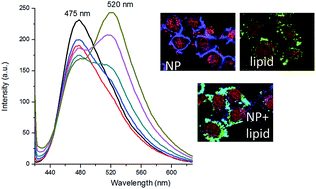The influence of fluorescent silica nanoparticle surface chemistry on the energy transfer processes with lipid bilayers†
Abstract
Multifunctional nanoparticles (NPs) are an advantageous scaffold for assembling hybrid bio-inorganic nanoplatforms, with impact on key technologies, including molecular diagnostics, therapeutics, bioengineering, biocatalysis, energy generation and storage. In the present work we used core–shell silica NPs, coumarin-doped in the core and surface-tailored with different chemical moieties (–PEG, –COOH, –NH2), as a possible nanocarrier for drug delivery and imaging. The nanoparticle surface was further decorated with lipid bilayers by the interaction with fluorescent small unilamellar lipid vesicles bearing different charges, namely zwitterionic (PC), anionic (PS25) and cationic (EPC25). The fluorescence energy transfer (FRET) processes between the silica nanoparticles and the lipid bilayers, dye-labelled with nitrobenzoxadiazole and/or rhodamine fluorescent moieties, were investigated to exploit the behaviour of the hybrid biomembrane–NP assembly as a theranostic nanocarrier. A relevant role of electrostatic interactions to influence the photophysical properties of the hybrid lipid–NP systems resulted. In proof-of-concept cellular experiments, an increased cellular internalization of NP–PEG/PS25 and NP–NH2/PS25 compared to the respective bare nanoparticles was observed, as well as a decreased cellular uptake, both in the nuclei and in the cytoplasm, in both NP–PEG/EPC25 and NP–COOH/EPC25 systems with respect to the cationic lipids alone. Moreover, intracellular FRET processes were detected by in vitro cell imaging with confocal microscopy, emphasizing the potentialities of such nanoplatforms in theranostic applications.



 Please wait while we load your content...
Please wait while we load your content...